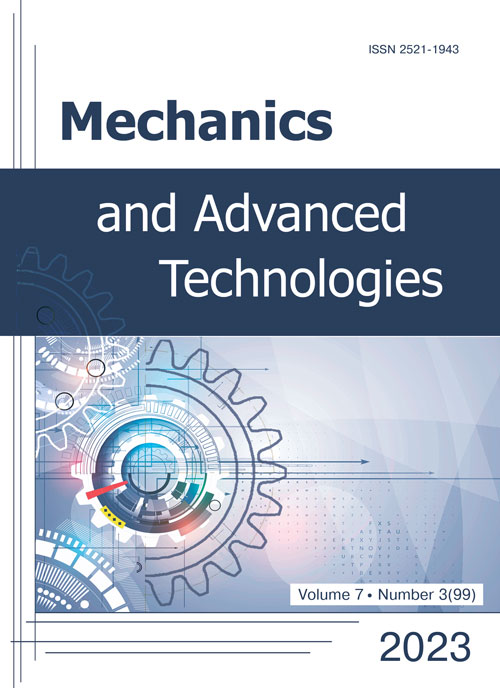The potential of using 3D printing in the manufacture of mini hydraulic systems
DOI:
https://doi.org/10.20535/2521-1943.2023.7.3.294001Keywords:
3D printing, hydraulics, robotics, hydraulic cylinderAbstract
The work is devoted to an analytical engineering study of the practicality of using 3D printing for the manufacture of hydraulic components, in order to solve the problems associated with weight, size and complexity inherent in traditional hydraulic elements. The research aims to demonstrate the feasibility of using 3D printing to achieve simplified design and increased efficiency. The work presents samples of hydraulic elements printed on a 3D printer, which reflects the practical feasibility of this approach. A simple and practical design methodology is proposed for two key components of a typical hydraulic system, namely, a hydraulic cylinder and a directional servo-valve, which allows hydraulic actuators to be controlled using any programmable microcontroller. A distinctive feature of this approach is the emphasis on the principles of compact design, which facilitates the integration of many parts into single, multifunctional part. In addition, the use of lightweight materials in 3D printing helps reduce the overall weight of hydraulic components. The proposed method also allows the integration of various hydraulic elements into a single integral structure printed on a 3D printer, offering a pragmatic solution to the size and complexity issues associated with traditional metal hydraulic systems. The scope of this innovative approach extends to the creation of prototypes of hydraulic and pneumatic robots, as well as devices that require compactness, precision and adaptability. This methodology is promising for implementation in the field of robotics, especially for tasks where space and weight constraints are critical factors.
References
- О. Levchenko, “Study of energetic balance of the hydraulic system with fixed displacement pump and pressure relief valve”, Mech. Adv. Technol., no. 2 (80), pp. 123–133, Nov. 2017. DOI: https://doi.org/10.20535/2521-1943.2017.80.111969.
- Y. Lukashchuk, I. Behm and O. Levchenko, “Energy efficiency of pneumatic systems as part of the Industrial Revolution 4.0 features”, Mech. Adv. Technol., no. 2 (83), pp. 87–93, Oct. 2018. DOI: https://doi.org/10.20535/2521-1943.2018.83.133097.
- Hydraulik – Fluid-Mechatronik: Grundlagen, Komponenten, Systeme, Messtechnik und virtuelles Engineering, N. Gebhardt, J. Weber (eds). Berlin, Heidelberg: Springer Vieweg, 2020. DOI: https://doi.org/10.1007/978-3-662-60664-3.
- D. Findeisen and S. Helduser, Ölhydraulik: Handbuch der hydraulischen Antriebe und Steuerungen. Berlin, Heidelberg: Springer Vieweg, 2015. DOI: https://doi.org/10.1007/978-3-642-54909-0.
- L. G. Kozlov, V. V. Bogachuk, V. V. Bilichenko, A. O. Tovkach, K. Gromaszek and S. Sundetov, “Determining of the optimal parameters for a mechatronic hydraulic drive”, in Photonics Applications in Astronomy, Communications, Industry, and High-Energy Physics Experiments 2018. Wilga, Poland, 2018, p. 99. DOI: https://doi.org/10.1117/12.2501528.
- O. R. Peña and M. J. Leamy, “An efficient architecture for energy recovery in hydraulic elevators”, International Journal of Fluid Power, vol. 16, no. 2, pp. 83–98, 2015. DOI: https://doi.org/10.1080/14399776.2015.1055991.
- M. Karvonen, M. Heikkilä, M. Huova and M. Linjama, “Analysis by Simulation of Different Control Algorithms of a Digital Hydraulic Two-Actuator System”, International Journal of Fluid Power, vol. 15, no. 1, pp. 33–44, 2014. DOI: https://doi.org/10.1080/14399776.2014.893710.
- A. М. Murashchenko, A. P. Gubarev, O. M. Yakhno and O. V. Tyzhnov, “Calculation of hydraulic channels of drives with taking in to account temperature and viscosity changes”, Mech. Adv. Technol., no. 2 (83), pp. 5–10, Oct. 2018. DOI: https://doi.org/10.20535/2521-1943.2018.83.118414.
- G. Avrunin, M. Podrigalo, I. Moroz and O. Koval, “Analysis of the technical level of hydraulic fluid power with motor-wheels”, Mech. Adv. Technol., vol. 7, no. 2 (98), pp. 185–192, Sep. 2023. DOI: https://doi.org/10.20535/2521-1943.2023.7.2.277557.
- F. Razavi and O. Koval, “Peculiarities of physical modeling of hydrodynamics of flow in conical slide bearings”, Mech. Adv. Technol., no. 1 (82), pp. 51–57, May 2018. DOI: https://doi.org/10.20535/2521-1943.2018.82.123323.
Downloads
Published
How to Cite
Issue
Section
License
Copyright (c) 2023 Олег Левченко, Іван Костюченко

This work is licensed under a Creative Commons Attribution 4.0 International License.
Authors who publish with this journal agree to the following terms:
- Authors retain copyright and grant the journal right of first publication with the work simultaneously licensed under CC BY 4.0 that allows others to share the work with an acknowledgement of the work's authorship and initial publication in this journal.
- Authors are able to enter into separate, additional contractual arrangements for the non-exclusive distribution of the journal's published version of the work (e.g., post it to an institutional repository or publish it in a book), with an acknowledgement of its initial publication in this journal.
- Authors are permitted and encouraged to post their work online (e.g., in institutional repositories or on their website) prior to and during the submission process, as it can lead to productive exchanges, as well as earlier and greater citation of published work











